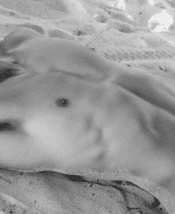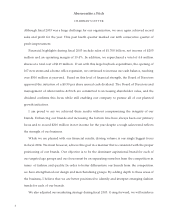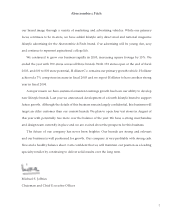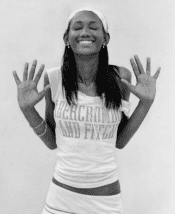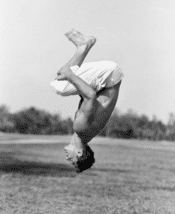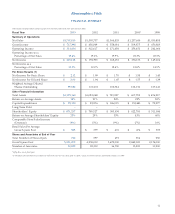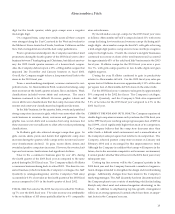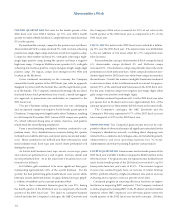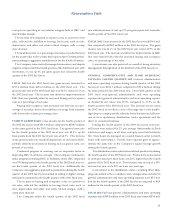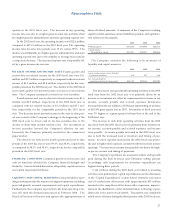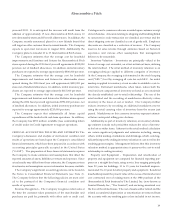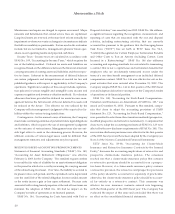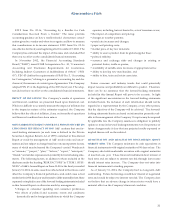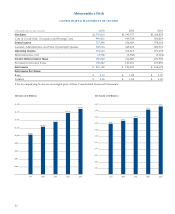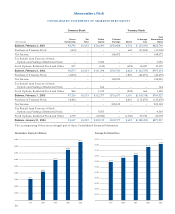Abercrombie & Fitch 2003 Annual Report Download - page 16
Download and view the complete annual report
Please find page 16 of the 2003 Abercrombie & Fitch annual report below. You can navigate through the pages in the report by either clicking on the pages listed below, or by using the keyword search tool below to find specific information within the annual report.
Abercrombie &Fitch
FOURTH QUARTER 2002 Net sales for the fourth quarter of the
2002 fiscal year were $534.5 million, up 15% over 2001’s fourth
quarter net sales of $466.6 million. Comparable store sales decreased
4% for the quarter.
By merchandise concept, comps for the quarter were as follows:
Abercrombie & Fitch’s comps declined 5%, with womens achieving
positive low-single digit comps and mens a mid-teen negative comp.
Comps for abercrombie declined 4%, with girls achieving a high-
single digit positive comp during the quarter and boys a negative
high-teen comp. Comps in Hollister were a positive 16%, with girls
achieving low twenties positive comps and guys a high- single digit
positive comp. By region, comps were strongest in the West and
weakest in the Midwest.
Given continued uncertainty in the economy, the Company
entered the fourth quarter of the 2002 fiscal year with an approach
designed to protect both the bottom line and the aspirational quali-
ty of the brands. The Company continued to strategically use direct
mail and bounce-back promotions, but, overall, a much less aggres-
sive approach to promotions was undertaken as compared to the
2001 fiscal year.
The pre-Christmas selling environment was very challenging
and, as expected, comps were negative for the fourth quarter prior to
Christmas. Comps improved significantly after Christmas, resulting
in a flat comp for December 2002. January 2003 comps were positive
3%, which reflected strong sales of winter clearance, and positive
results from the initial Spring assortment.
From a merchandising standpoint, womens continued to out-
perform mens. Key classifications in womens during the quarter
included woven shirts, knit tops, outerwear, pants, sweats and under-
wear. Mens continued to be difficult and there remained no solid
trend industry-wide. Knit tops and woven shirts performed well
during the quarter.
As for the kids’ business, knit tops, sweats, woven tops, pants
and outerwear performed very well in girls. In boys, denim and
sweats performed best. As in the adult men’s business, boys con-
tinued to be difficult.
In Hollister, girls continued to be more significant than guys,
representing approximately 65% of the overall business. For the
quarter, the best performing girls classifications were woven shirts,
knit tops, sweats, skirts and denim. In guys, denim, knit tops, graph-
ic t-shirts, sweatshirts and accessories performed best.
Sales in the e-commerce business grew by over 25% during
the fourth quarter of the 2002 fiscal year as compared to the fourth
quarter of the 2001 fiscal year. The direct to consumer business
(which includes the Company’s catalogue, the A&F Quarterly and
the Company’s Web sites) accounted for 5.0% of net sales in the
fourth quarter of the 2002 fiscal year as compared to 4.5% in the
2001 fiscal year.
FISCAL 2002 Net sales for the 2002 fiscal year reached $1.6 billion,
up 17% over the 2001 fiscal year. The sales increase was attributable
to the net addition of 106 stores offset by a 5% comparable store
sales decrease.
By merchandise concept, Abercrombie & Fitch comps declined
6%, abercrombie comps declined 4% and Hollister comps
increased 10%. The decline in comps was primarily due to the weak
performance in both mens and boys. Mens comps decreased in low-
double digits for the 2002 fiscal year while boys comps decreased in
the mid-teens. Overall, the women’s and girls’ businesses continued
to increase in share of the total business and accounted for approx-
imately 57% of the adult and kids’ businesses in the 2002 fiscal year.
For the year, womens comps were negative low-single digits while
girls comps were positive mid-single digits.
Hollister continued to perform well. For the 2002 fiscal year, sales
per square foot in Hollister stores were approximately 86% of the
sales per square foot of Abercrombie & Fitch stores in the same malls.
The Company’s catalogue, the A&F Quarterly and the
Company’s Web sites represented 4.7% of the 2002 fiscal year net
sales compared to 4.2% in the 2001 fiscal year.
GROSS INCOME The Company’s gross income may not be com-
parable to those of other retailers since all significant costs related to the
Company’s distribution network, excluding direct shipping costs
related to the e-commerce and catalogue sales, are included in general,
administrative and store operating expenses (see “General,
Administrative and Store Operating Expenses” section below).
FOURTH QUARTER 2003 Gross income for the fourth quarter of the
2003 fiscal year was $261.0 million compared to $243.0 million in the
2002 fiscal year. The gross income rate (gross income divided by net
sales) for the fourth quarter of the 2003 fiscal year was 46.6%, up 110
basis points from last year’s rate of 45.5%. The increase in gross
income rate resulted largely from an increase in initial markup
(IMU), partially offset by a higher markdown rate and an increase
in buying and occupancy costs as a percent of net sales.
Continued progress in sourcing efficiency has been an impor-
tant factor in improving IMU and profit. The Company continued
to make progress increasing IMU in the Hollister and abercrombie
business, where IMU improved over 400 basis points versus the
fourth quarter of the 2002 fiscal year for both concepts. All three
14



